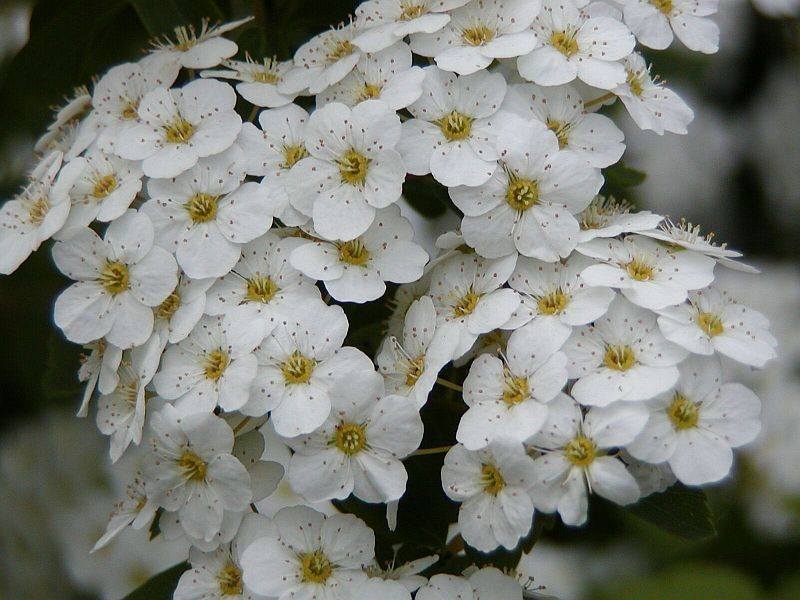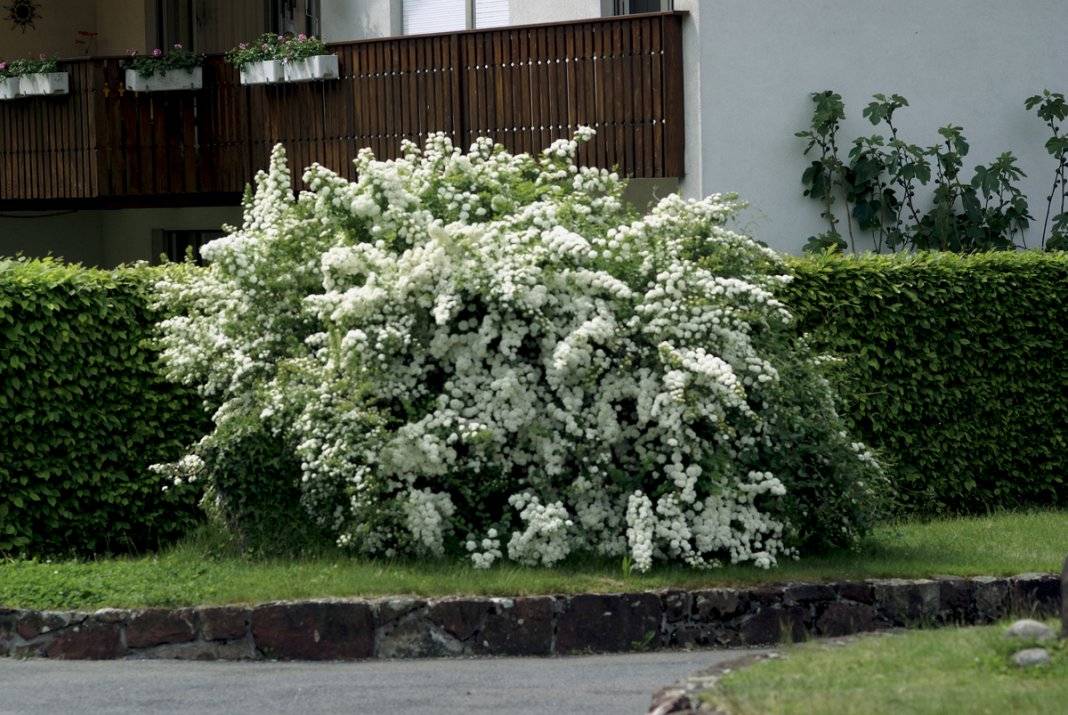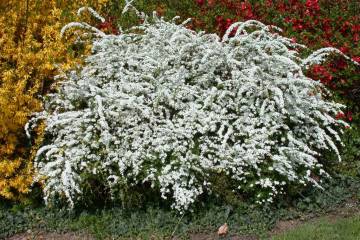Spirea Wangutta - botanical description and varieties
Content:
Spirea Vangutta (botanical name Spiraea Vanhouttei) is characterized by lush and abundant flowering. A small shrub is widely used in landscape design. The plant has about 40 varieties with different colors of leaves and flowers.
Description of spirea Wangutta
Spirea Vangutta (Spiraea Vanhouttei) is a perennial spreading shrub belonging to the Pink family. The plant, depending on the variety, can have both a cascading hanging and an erect crown. Wangutta is a hybrid obtained not as a result of breeding work, but naturally in nature.
Spirea has a two-meter height and the same width, but erect varieties can stretch up to 3 m in length. In the first years of life, the bush grows 20 cm annually, but soon slows down its growth.
Small leaf plates of the plant have an oval ovoid shape, serrated along the edges. Their length is on average 4 cm, and the color is deep green on the front side and gray on the back. However, there are varieties with a different shade of plates, for example, the Spirea Golden Fountain (Fountain Gold) has yellow foliage. This in no way indicates illness and the beginning of the deciduous period. In the Pink Ice spirea, the color of the sheets is even more decorative - white-green on the front and lilac on the back.
Planting a plant
Growing a plant from seedlings at home begins in early spring or February. To plant seeds, you need to buy from a trusted seller or place an order on the Internet on the breeders' website, for example, in the well-known Rusroz nursery in Russia.
Planting from seeds
Before sowing seeds, you first need to prepare the planting material itself and the soil. It is better to keep the seeds in a disinfecting solution; you can use a regular unconcentrated infusion of potassium permanganate. The substrate can be purchased at the store, but it is not difficult to prepare it yourself, for this it is enough to mix the turf soil with a small amount of sand and peat.
Pour nutritious soil mixture into a shallow box and slightly moisten it from a spray bottle. Then plant each seed to a depth of 2-3 cm and pour cold clean water.
Planting seedlings in open ground
In late April or early May, you can transplant seedlings into the garden. For cultivation, it is better to choose lighted areas with sandy loam soil. The passage of groundwater should be as low as possible, so you need to plant a bush not in lowlands, but in hilly places.
A hole for planting is dug up to a depth of 40-50 cm. Its bottom is covered with a 10-cm layer of drainage material; expanded clay is well suited. Then sprinkle with the same layer of substrate or ordinary soil. The seedlings soaked in water for several days are placed in a hole and sprinkled with earth. The root collar must be left above the soil surface. It is advisable to water each planting with river water.
How to care for Wangutta spirea
If you carry out the correct planting of the seedling in the ground and create the most favorable conditions for growing it, then caring for the spirea will not cause trouble.
Watering
The plant will grow well and bloom beautifully with regular watering with good quality water. This should be done twice a month, and in case of prolonged drought, increase the procedure up to 4 times a month. For each bush, you need to spend at least 1 bucket of soft room temperature water.
Top dressing
Spirea Wangutta is not particularly demanding on frequent feeding. After planting the seedling in the ground and applying fertilizer, you can feed the plant only for the next year. For this purpose, both complex mineral fertilizers and organic matter are used. Humus, rotted manure or compost is applied after spring sanitary pruning. Then, until the beginning of summer and the appearance of the first flowers, the bush is fertilized with urea or ammonium nitrate, during the budding period the plant is allowed to rest and, after flowering, once a month, it is fed with phosphorus-potassium preparations.
Pruning
Spirea without scraps can have many problems. The first pruning of the season is carried out for sanitary purposes in the spring after waking up, old branches are removed. To form the crown of the shrub, you need to cut the plant immediately after flowering.
Reproduction methods
It is easier and easier to propagate spirea at home by cuttings and dividing the bush. To root cuttings, you first need to cut them from young, but strong and healthy shoots. These scraps need to be buried in a peat-earthen mixture and watered. Cover the top with foil and put in a lighted place. After the appearance of stable roots, it can be planted in open ground.
Reproduction by dividing the bush is often done when transplanting and renewing the spirea. This is one of the fastest and most hassle-free ways. The whole plant is dug up and divided, together with the rhizome, into several identical parts. Each of the resulting parts is planted in a separate area.
Transfer
Transplants are carried out in order to rejuvenate the bush or when a disease appears, in which it is necessary to dig up the plant, cut off the infected areas and plant in a new place with healthy soil. It is recommended to transplant the plant once every 5-7 years, since any soil tends to deplete even with proper feeding.
Diseases and pests
Spirea Wangutta has good resistance to diseases and insect pests, but with improper care it becomes more susceptible to them. The plant can be infected with aphids, slugs and gall midges, which can be the reason why the bush stops blooming. You can identify the problem by conducting a visual inspection at the early stages of the problem. To fight pests, it is necessary to treat the bush with insecticides and, before budding, to prevent diseases, spray it with phytoverm.
Due to fungal diseases and powdery mildew, gray spots appear on the leaves and stems. The treatment of Vangutta spirea with a solution of copper sulfate and Bordeaux liquid helps to cope with them.
Flowering period
It begins to bloom in small, abundant buds in May and lasts about 1.5 months until mid-summer. Thick and lush flowers are white and collected in large spherical inflorescences.
Preparing for winter
In the southern and middle latitudes, you do not need to cover the bush for wintering, just cut it off and mulch the trunk circle. In the Urals and Siberia, additional protection will be required, even for frost-resistant varieties. In order not to weaken the spirea, before wintering, it is necessary to cut off its shoots by a third. The trunk circle needs to be piled up and covered with a thick layer of dry leaves, straw and peat. Young bushes should be covered with lightweight, breathable protective material.
Use in landscape design
Spirea is one of the most popular flowering shrubs in home gardening. With its help, they make out:
- single garden compositions;
- alleys;
- hedges;
- small flowering parks;
- plots near reservoirs.
Spirea Gold Fontaine will look beautiful in parks and with a single planting on a personal plot. For a more colorful garden arrangement, it would be a good idea to plant several types of Wangutta spirea together.
Spirea Wangutta has strong immunity. It can be grown even in harsh regions, while the shrub does not lose its high decorative qualities. A large number of plant varieties will help to decorate any garden area.




















